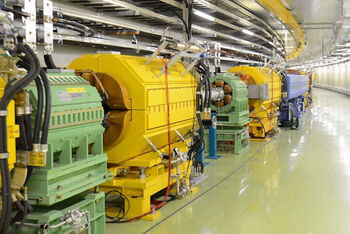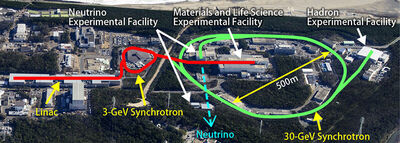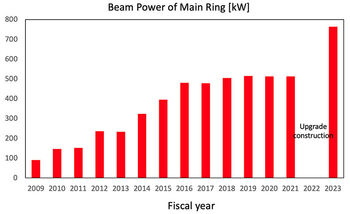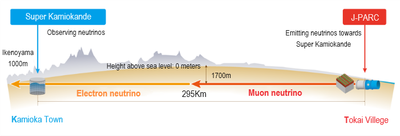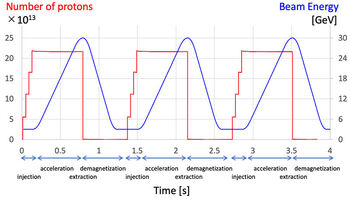Significant Increase in Beam Power and Electric Power Efficiency of the J-PARC Main Ring Accelerator
- A Powerful Driving Force for Neutrino Research -
J-PARC Center
High Energy Accelerator Research Organization (KEK)
Japan Atomic Energy Agency (JAEA)
Story of this research
Background
∗ At Japan Proton Accelerator Research Complex (J-PARC) in Tokai Village, Ibaraki Prefecture, we accelerate high-intensity proton beams to near light speed, conducting experiments to observe and reveal unknown phenomena in elementary particles and atomic nuclei. We have continuously endeavored to increase 'beam power,' a key indicator determined by the number of accelerated protons supplied to experimental facilities, crucial for the success of our experiments.
Achievements
∗ At the accelerator, 'Main Ring,' we have incrementally increased beam power since the start of operations in 2008. On December 25, 2023, we surpassed our initial target, achieving a beam power of 760 kW through significant enhancements. Efficiently recovering and reusing energy stored in the electromagnets not only allowed us to supply beam power 1.5 times greater with the same electricity consumption but also resulted in significant energy savings.
Meaning
∗ At J-PARC, the 'T2K experiment' delves into neutrino fundamentals. Neutrino research in Japan is playing the leadingrole in the world, with Nobel Prizes being awarded. It is expected that the beam power increase will enhance the T2K experiment and the following Hyper-Kamiokande project will produce new results first in the world.
Electromagnets at J-PARC's Main Ring
50 words summary
We surpassed our initial target, achieving a beam power of 760 kW, a crucial indicator at the Japan Proton Accelerator Research Complex (J-PARC), while concurrently achieving significant energy savings. This success paves the way for the Hyper Kamiokande project, with expectations of a drastic enhancement of the T2K experiment.
Overview
The Japan Proton Accelerator Research Complex (J-PARC) in Tokai Village, Ibaraki Prefecture, is a high-intensity proton accelerator facility jointly constructed and operated by the High Energy Accelerator Research Organization (KEK) and the Japan Atomic Energy Agency (JAEA). J-PARC conducts cutting-edge research across a wide range of research, including elementary particle physics, atomic nuclei physics, condensed matter physics, chemistry, material science, and biology. The administrative entity overseeing its operations is called the J-PARC Center.
The proton beam undergoes staged acceleration through three accelerators: a linear accelerator (LINAC), a circular accelerator called the Rapid-Cycling Synchrotron (RCS), capable of accelerating particles up to 3 GeV (gigaelectron volts, a unit of kinetic energy), and another circular accelerator called the Main Ring. Through these accelerators, proton beams are supplied to experimental facilities, including the Neutrino Experimental Facility.
Accelerated protons collide with targets, generating particles (neutrons, K mesons, and neutrinos) used in experiments. Experiment sensitivity depends on the total produced particles, directly proportional to incident protons. Higher sensitivity requires more protons. Achieving this relies on 'beam power' (*1), the number of accelerated protons per unit time, measured in kilowatts (kW).
The Main Ring is a synchrotron circular accelerator initially designed with a target performance of 750 kW. Through numerous beam adjustments and improvements, the beam power reached 500 kW in 2019. Substantial upgrades to the accelerator were implemented, and since the fiscal year 2022, it has been in acceleration tuning operation. On December 25, 2023, it successfully achieved a record-breaking beam power of 760 kW, as shown in Graph 1.
Graph 1: Annual Maximum Beam Power of the Main Ring
We have implemented a technique that employs large-capacity capacitors for the power supplies for the electromagnets, utilizing magnetic force to guide the beam into a circular orbit. This innovative approach efficiently repurposes the energy stored in the magnets, enabling us to achieve a beam power of 760 kW with the same power consumption as before the Main Ring enhancement. This translates to an approximately 1.5 times increase in beam power without an increase in power consumption.
At the Neutrino Experimental Facility, which utilizes protons accelerated in the Main Ring, the apparatus for generating neutrinos has been strengthened to endure high beam power, with improvements in radiation shielding. On December 25, 2023, stable and continuous production of neutrinos was achieved at a record-breaking beam power of 760 kW.
※1. Beam power
Beam power is the product of the kinetic energy of protons and the number of protons extracted per unit of time. It serves as a performance indicator for the accelerator and is the determining factor in the production of secondary and tertiary particles.
A word from the researchers
Professor IGARASHI Susumu from the Accelerator Division at J-PARC Center: Through the efforts of each team member and excellent teamwork in equipment upgrades and beam tunings, we have successfully reached a long-awaited goal that involved the dedication of many individuals. I am deeply moved and relieved by this accomplishment. Looking ahead, I am committed to continuing our research and striving for even higher achievements.
Why did you start this research?
One of the key experiments utilizing the J-PARC Main Ring beam is the T2K experiment (Tokai to Kamioka Long-baseline Neutrino Oscillation Experiment, *2). This experiment aims to investigate the fundamental properties of neutrinos, elementary particles. Protons accelerated up to 30 GeV in the Main Ring, are extracted and directed to the neutrino experimental facility, where they irradiate a target.
The neutrinos, created by converging the secondary particles generated there, are observed by the Super-Kamiokande detector located 295 km away in Kamioka-cho, Hida City, Gifu Prefecture. To precisely measure the changes caused by the long-distance flight of neutrinos, which have minimal interactions with matter, a substantial number of neutrinos are needed. This, in turn, requires a high beam power of protons, the particles generate neutrinos.
※2. T2K Experiment
To solve the mystery of neutrinos, J-PARC's Main Ring and Experimental Facility generate a high-intensity neutrino beam directed 295 km to the Super-Kamiokande detector, a 50,000-ton water Cherenkov detector operated by Institute for Cosmic Ray Research, the University of Tokyo, located 1,000 meters underground in Kamioka, Hida City, Gifu Prefecture.
Overview of T2K Experiment
Where did you put in the effort?
The Main Ring, operating as a synchrotron-type accelerator, receives a 3 GeV beam from the preceding accelerator, accelerates it to 30 GeV, and emits a single pulse toward the experimental facility. The electromagnets' magnetic field is then adjusted back to 3 GeV for the next beam injection, and this cycle is repeated. To enhance the beam power in the Main Ring, the following modifications are necessary.
To increase accelerated protons, minimizing beam losses is crucial. Despite repulsive forces, protons undergo over 100,000 turns in the Main Ring. Precision adjustments to magnetic fields and RF accelerator voltages are necessary to minimize beam loss. Even minor errors in magnetic fields can lead to beam loss, so the magnets' fields are finely tuned. Beam tuning in front-end accelerators (Linac and RCS) collaborates to minimize Main Ring beam loss. Exploring optimal conditions, addressing instabilities, and adding equipment contributed to the Main Ring achieving a 500kW beam power in 2019, with 265 trillion protons per pulse, a world record for synchrotron-based proton accelerators.
The operation was on an extended pause starting in the summer of 2021, and a significant modification was implemented to reduce the cycle repetition period from 2.48 seconds to 1.36 seconds.
The modifications encompass various equipment, including devices for injecting the proton beam into the Main Ring, a radio frequency accelerator giving proton energy, a power supply for the main electromagnet to control the proton beam's orbit, and equipment for extracting the accelerated proton beam to the experimental facilities. Following the commissioning of the upgraded equipment and successful confirmation of its stable operation, beam tunings with a repetition rate of 1.36 seconds and beam supply operations to the neutrino experimental facility commenced in 2023. On December 25, the beam power reached 760 kW, as depicted in Graph 2.
In Graph 2, the red line shows the measured number of protons circling the main ring, while the blue line represents the beam energy. At 12:00 on December 25, the beam power was 763 kW, and 216 trillion protons were extracted. The cycle involves 'injection,' 'acceleration,' 'extraction,' and 'demagnetization,' repeating every 1.36 seconds. The beam current briefly drops to zero at extraction, indicating a pulsed extraction of the proton beam.
In the Neutrino Experimental Facility, electromagnets (electromagnetic horns) that collect secondary particles have been reinforced so that they can be excited with the Main Ring's 1.36-second cycle. Cooling systems for devices, such as the target, exposed to thermal shock from high-power pulsed proton beam irradiation, have been strengthened. Furthermore, facilities like radiation shielding have been reinforced to protect the surrounding environment. These improvements enable to utilize the Main Ring's performance, and to supply more neutrinos stablely for experiments than ever before.
The goal of accelerating a globally unprecedented number of protons, coupled with the challenging task of minimizing beam loss, took 15 years to achieve. This involved incrementally increasing beam power and making substantial improvements to the Main Ring to navigate unforeseen challenges. The efforts include repeated beam tunings and modifications of the Linac and RCS for the performance of the Main Ring. This accomplishment marks a significant milestone in our journey.
We will continue advancing beam tunings to further reduce beam loss and enhance overall operational stability.
How would that change the world?
The main aim of the T2K experiment is to search the differences in properties between neutrinos and antineutrinos, a phenomenon referred to as 'CP violation.' Understanding this distinction is crucial for unraveling why antimatter vanished, leaving only matter to shape the present cosmos, despite the same amount of matter and antimatter produced during the universe's birth. Achieving this objective necessitates thorough data acquisition.
In the future, toward the Hyper-Kamiokande Project (*3), the next-generation neutrino research following the T2K experiment, we plan to further reduce the repetition rate to 1.16 seconds and expand the RF accelerator to increase the number of extracted protons to 330 trillion, aiming to raise the beam power to 1.3 MW by 2028.
※3. Hyper-Kamiokande Project
This experiment aims to complete the ununified theory of elementary particles and to explore the evolution of the universe by precisely observing proton decay and neutrinos. A new detector is under construction next to the Super-Kamiokande facility in Kamioka Town, Hida City, Gifu Prefecture. The detector, a cylindrical tank filled with ultrapure water, will have a diameter of 68 meters and a depth of 71 meters, with a sensitivity about 10 times higher than the Super-Kamiokande. The experiment is set to begin in 2027.

